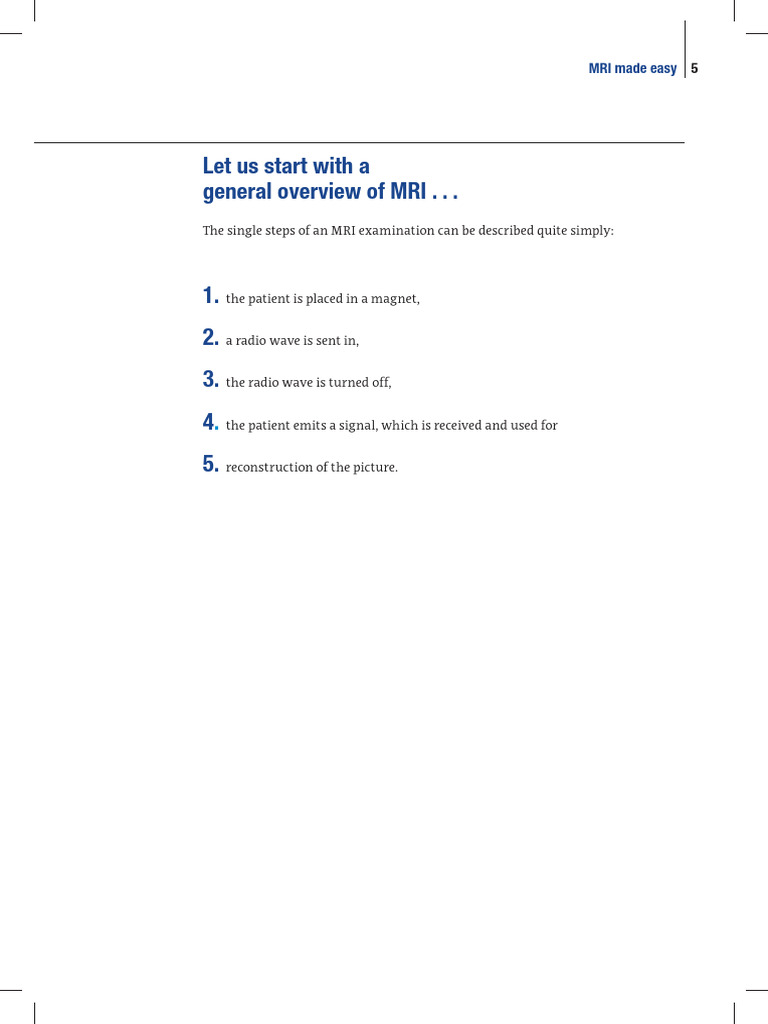In the realm of medical imaging, Magnetic Resonance Imaging (MRI) stands as a cornerstone, revolutionizing diagnostic procedures and enhancing our understanding of human anatomy and pathology. Yet, amidst its remarkable utility, there exists a notable curiosity surrounding its nomenclature. Specifically, the ‘R’ in MRI beckons inquiry. What does this letter represent, and why does its significance extend beyond mere definition? In this discourse, we will delve into the deeper implications of the ‘R’ in MRI, unearthing avenues of fascination that elucidate its essential role in the medical landscape.
The terminology of MRI is deceptively succinct. The acronym ‘MRI’ encapsulates the intricate interplay between magnetic fields, radiofrequency waves, and biological tissues. While the ‘M’ signifies ‘Magnetic,’ and the ‘I’ represents ‘Imaging,’ it is the ‘R’ that elicits intrigue. It denotes ‘Resonance,’ a concept rooted in the principles of physics and vital in the operational mechanism of this technology. Resonance, in a broad scientific context, refers to the tendency of systems to oscillate at greater amplitudes at specific frequencies. This phenomenon plays a pivotal role in medical imaging, facilitating the acquisition of crucial data that informs clinical decision-making.
The magnetism of resonance, particularly in the context of MRI, arises from the behavior of hydrogen nuclei within the human body. The human organism is predominantly composed of water, which contains hydrogen atoms in abundance. When a patient is positioned within the strong magnetic field of an MRI scanner, the protons in these hydrogen atoms align with the magnetic field. The subsequent application of radiofrequency energy prompts these protons to absorb energy and resonate, temporarily shifting from an equilibrium state. Upon removal of this external energy, the protons return to their original alignment, releasing energy in the process. This emitted energy is detected and translated into images, revealing detailed insights into the structure and condition of tissues.
The clinical applications of this remarkable technique are vast, encompassing a myriad of specialties including neurology, orthopedics, cardiology, and oncology. Through the resonance of protons, MRI can delineate fine anatomical structures, enabling the detection of abnormalities such as tumors, lesions, and degenerative diseases with unparalleled precision. The specificity of MRI imaging is augmented by various contrasting agents, which enhance the visibility of certain tissues, thereby assisting in the diagnostic process.
Moreover, the profound implications of ‘resonance’ extend into the psychological dimensions of patient experience as well. The prospect of undergoing an MRI scan may evoke feelings of apprehension or anxiety for some individuals. Understanding the science behind resonance can mitigate these fears, transforming an experience perceived as daunting into one that exemplifies technological marvel. As physicians elucidate the mechanics of MRI, patients may find reassurance in the knowledge that their physiological responses are a natural part of the imaging process. This understanding can bridge the gap between clinical practice and patient education, fostering a collaborative framework that enhances patient satisfaction.
On a broader scale, the exploration of resonance within the context of MRI invites a deeper reflection on the intersections of physics, biology, and technology in modern medicine. The capacity of MRI to provide clear, cross-sectional images of soft tissues without ionizing radiation differentiates it from other imaging modalities such as computed tomography (CT) or X-rays. This non-invasive approach aligns with the principles of patient-centered care, prioritizing safety while simultaneously offering intricate diagnostic insights.
In addition, the expansive reach of MRI technology has catalyzed advancements within research domains. The methodology employed in MRI investigations has opened new frontiers in the study of neurodegenerative disorders, allowing researchers to observe changes in brain structure and function over time. Such investigations underscore the importance of resonance not only as a mechanism for imaging but as a powerful tool for expanding the boundaries of medical knowledge and contributing to innovative therapeutic strategies.
Furthermore, as medical professionals continue to harness the potential of resonance, the implications extend to future developments in imaging technologies. The evolution of functional MRI (fMRI), an advanced form of MRI that measures and maps brain activity, exemplifies this trajectory. By capitalizing on the principles of resonance, fMRI enables real-time visualization of neural dynamics, expanding our comprehension of brain function and paving the way for interventions in psychiatry and neurology.
In summary, the ‘R’ in MRI signifies ‘Resonance,’ a term that encapsulates both a fundamental scientific principle and a profound functional capability within medical imaging. This resonance not only facilitates the remarkable clarity of MRI imaging but also serves as a metaphor for the symbiotic relationship between technology and medicine. As we continue to unravel the complexities of human health, the resonance of protons in our bodies emerges as a powerful reminder of the intersection of knowledge and care. Through the lens of resonance, we can appreciate the intricate dance between physics and physiology that underpins the efficacy of MRI, fostering a greater understanding of this indispensable tool in modern medicine. The journey of discovery within the framework of MRI is far from over; it invites continuous exploration, revealing the depths of fascination intertwined with every scan.












